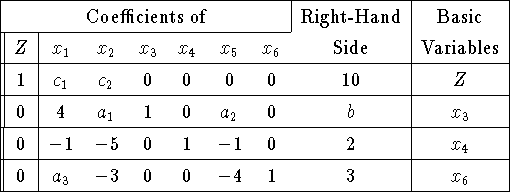Suppose you have obtained the tableau given below for a maximization
problem.

State conditions on  ,
,  ,
,  , b,
, b,  and
and  that are required to make the following statements true:
that are required to make the following statements true:
-
(a) The current solution is not a basic feasible solution.
-
-
b < 0. a1, a2, a3, c1 and c3 can be any real numbers.
-
This gives us a basic solution that is not feasible since it has x3 <0.
-
-
-
(b)The current solution is feasible, but the LP is unbounded.
-
-
We need b >= 0 for feasibility.
-
Given this, the problem is unbounded is c2 < 0 and a1 <= 0.
-
The other unknowns can be any real numbers.
-
-
(c) The current solution is feasible, but the objective function
can be improved by replacing
 as a basic variable with
as a basic variable with  .
.
-
-
We need b >= for feasiblity.
-
For x1 to enter the basis and improve the solution, we need c1 < 0.
-
-
Suppose that x1 enters the basis. The ratio for x3 is b/4, the ratio for
x4 is 2/-1 and the ratio for x6 is 3/a3. Since x4 has a negative
ratio, it will not be the exiting variable.
-
Likewise, we need a3 > 0 for x6 to considered for the exiting variable.
-
-
Assuming a3 > 0, x6 will leave the basis if 3/a3 <= b/4.
-
-
c2 and a2 can be any real numbers.
-
-
-
(d) The current solution is optimal.
-
-
We need b >= 0 for feasibility and c1 >= 0 and c2 >= 0 for the solution
to be optimal.
-
a1, a2 and a3 can be any real numbers.
-
-
(e) The current solution is optimal and there is another
optimal basic feasible solution.
We need c1 and c2 >= 0 for optimality.
If b = 0 and a1 > 0, then we can bring x2 into the basis without
changing objective function value.
Alternatively, we can b >= 0, c2 = 0 and a1 > 0.
In this case, bringing x2 into the basis will not change the objective
function value.
Finally, we can have b >= 0, c1 = 0 and a3 can be any real number.
In this case, bringing x1 into the basis will not change the objective
function value.


![]() ,
, ![]() ,
, ![]() , b,
, b, ![]() and
and ![]() that are required to make the following statements true:
that are required to make the following statements true: